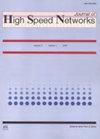Performance evaluation of contact-time based and adaptive-timer based message suppression methods for inter-vehicle communication in vehicular DTN
IF 1
Q4 COMPUTER SCIENCE, INFORMATION SYSTEMS
引用次数: 0
Abstract
In the next generation wireless networks, the number of connected terminals to the network, communication protocols, and the channels available will be increased, thus network slicing will become more important. Also, vehicles, buses, trains and motorcycles are considered communication terminals. These communication terminals should have independent network management considering their movement such as joining and leaving the networks. Therefore, Delay-Disruption-Disconnection Tolerant Networking (DTN) has been attracting attention for their potential support of inter-vehicle communication. In this paper are presented the Contact-Time (CT) based and Adaptive-Timer (AT) based Message Suppression (MS) methods for Vehicular DTN. For the CT-based MS method are used three DTN protocols for Vehicle-to-Vehicle (V2V) and Vehicle-to-Infrastructure (V2I) communication. For AT-based MS are used conventional Epidemic and two proposed Epidemic-based methods for V2V communication. We compare MS method, Message Suppression Controller (MSC) and MSC with Adaptive Threshold (MSC-ATh). The simulation results show that MSC-ATh performs better than other approaches. The storage consumption is improved when the number of vehicles increases and there is no reduction in PDR even if the message suppression is enabled. For Epidemic, when the number of Road-Side Units (RSUs) is 16, the results of PDR are the best compared with other DTN protocols. The MSC-ATh method is about 22% better than Epidemic for storage consumption. Also, the delay performance of MSC-ATh is improved by increasing the Suppression Coefficients (SCs) and number of vehicles.车载DTN中基于接触时间和自适应定时器的信息抑制方法性能评价
在下一代无线网络中,连接到网络的终端数量、通信协议和可用信道将会增加,因此网络切片将变得更加重要。此外,汽车、公共汽车、火车和摩托车也被视为通信终端。考虑到这些通信终端的入网、退网等活动,应该有独立的网络管理。因此,容忍延迟中断断开网络(Delay-Disruption-Disconnection tolerance Networking, DTN)因其对车辆间通信的潜在支持而备受关注。提出了基于接触时间(CT)和基于自适应定时器(AT)的车载DTN信息抑制方法。对于基于ct的MS方法,采用三种DTN协议进行车对车(V2V)和车对基础设施(V2I)通信。对于基于at的MS,分别采用了传统的Epidemic和两种基于Epidemic的V2V通信方法。我们比较了MS方法、消息抑制控制器(MSC)和带有自适应阈值的MSC (MSC- ath)。仿真结果表明,MSC-ATh算法的性能优于其他算法。当车辆数量增加时,存储消耗会得到改善,即使启用了消息抑制,PDR也不会减少。对于Epidemic,当Road-Side Units (rsu)的数量为16时,PDR与其他DTN协议相比效果最好。MSC-ATh法在存储消耗方面比Epidemic法高22%左右。同时,通过增加抑制系数(sc)和车辆数量,提高了MSC-ATh的延迟性能。
本文章由计算机程序翻译,如有差异,请以英文原文为准。
求助全文
约1分钟内获得全文
求助全文
来源期刊

Journal of High Speed Networks
Computer Science-Computer Networks and Communications
CiteScore
1.80
自引率
11.10%
发文量
26
期刊介绍:
The Journal of High Speed Networks is an international archival journal, active since 1992, providing a publication vehicle for covering a large number of topics of interest in the high performance networking and communication area. Its audience includes researchers, managers as well as network designers and operators. The main goal will be to provide timely dissemination of information and scientific knowledge.
The journal will publish contributed papers on novel research, survey and position papers on topics of current interest, technical notes, and short communications to report progress on long-term projects. Submissions to the Journal will be refereed consistently with the review process of leading technical journals, based on originality, significance, quality, and clarity.
The journal will publish papers on a number of topics ranging from design to practical experiences with operational high performance/speed networks.
 求助内容:
求助内容: 应助结果提醒方式:
应助结果提醒方式:


